








MIDWEEK UPDATE 15 JULY 2020Compiled by Willie Bodenstein     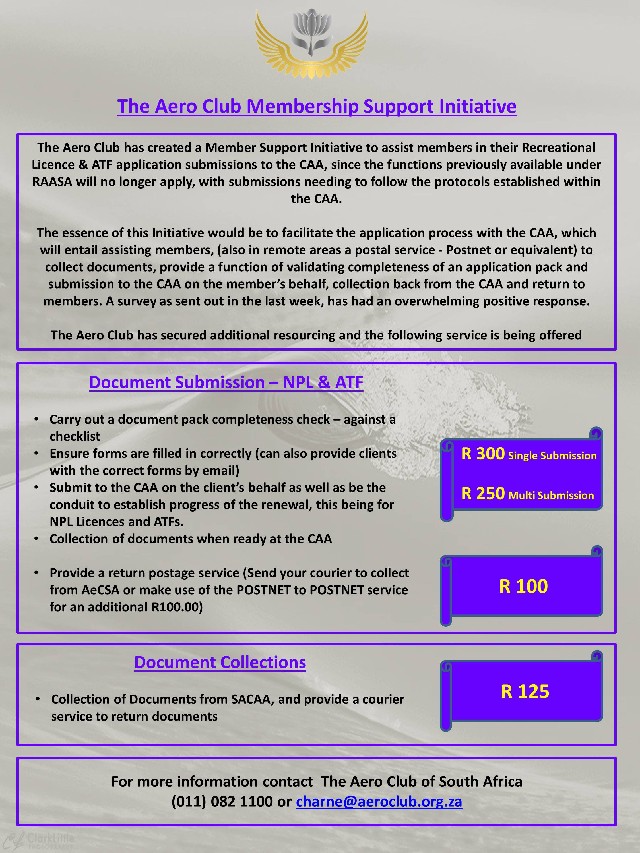  COVID 19 REGULATIONS AND INITIATIVES AND AEROCLUB NEWS STATUS ON GA / RA FLIGHT OPERATIONS IN LEVEL 3, PHASE 2 That said, although this is still a limiting flight regime, we are working in the background for further practical concessions related to proficiency and our sport, given that what we do is in very low C-19 risk environments. What is of course disconcerting, is that infection rates have become exponential in the bigger metros and new levels of protection are being implemented by the Government, we trust it won't affect Aviation as long as protocols are adhered to. Enjoy being back in the air, be safe and comply with the basics of C-19 protocols. One of the matters that is also now becoming a frustration point with our members, is that of ATFs that have been very slow in re-issue by the CAA, given their challenges of office closures and work from home policies over the last few months, We have as the Aero Club requested the Sections to provide inputs to share experiences from their Section members, so that we can collate this information for review with the CAA to be able to find solutions, thus if you can support their requests for input. We trust that we will be able to secure improvements in this regard going forward. www.aeroclub.org.za  In an effort to assist aircraft operators with any outstanding ATF queries, please let us know what has been issued and what is still awaiting as briefly as possible in the below form. We would appreciate your feedback urgently in order to include this in a survey that may assist with the processing of these documents. Please complete 1 form per ATF (aircraft). Once you have submitted, feel free to complete the form again for the next submission. In addition to outstanding ATF's and in order to understand the full scope of work processed, please indicate all AFT's issued as well outstanding ATF's. Please share this with anyone else that may also have a query. Help us to help you by sending us your info asap please. David Toma EAA National President president@eaa.org.za   CORONA VIRUS AND AVIATION EVENTS Due to Covid 19 and regulations regulating travelling as well as restrictions controlling the number of people congregating together, no aviation events will take place in the foreseeable future. Pilot's Post will advise our readers as soon as this changes.  EAA Flying Legend Talk Show with Karl Jensen Eventually, we will be able to enjoy an interview with Karl Jensen hosted by Scully Levin. We have been waiting for this Talk Show long before the March 2020 date that was set for the event before lockdown. Even with the current restrictions, we have joined the revolution and for the time being, will be hosting Talk Shows virtually, until such a time that we are able to gather at the Auditorium in person. Diarise now and we will keep you informed and circulate the meeting details to all members at a later stage. EAA of SA Auditorium Team rsvp@eaa.org.za 0832597691 PLEASE GO TO https://www.youtube.com/channel/UCCuRVZAGodT6sztTeXBGeMw and subscribe to our YouTube channel   CC POCK'S BUSH AND MOUNTAIN FLYING E-BOOK NOW AVAILABLE ON AMAZON KINDLE  The blurb on the back cover of the 2nd Edition of CC Pocock's Bush and Mountain Flying Guide reads: "Even if you never intend to become a bush pilot or fly in remote or mountainous areas, the information contained in this book will definitely make you more knowledgeable, leading you to become a much safer, more proficient and skilled pilot in general. Photo © Willie Bodenstein CC's credentials as an experienced bush pilot are not in doubt and his courses have been attended by more than 400 pilots from all over the world. In the 2nd edition he covers all techniques and procedures that will make flying in hostile terrain if not risk free, safer. Bush and Mountain Flying CC stress explore the very edge of the airplane's performance envelope and as such it remains the responsibility of the pilot to ensure that all techniques, procedures, manoeuvres, maintenance and repairs are fully within his or her capabilities. Now a resident of the USA CC's Advanced Bush and Mountain Flying, STOL and Tailwheel courses are available virtually every week throughout the year at his Bush Air home base at Kidewll airport (1L4), Cal Nev Ari, Nevada. Bush Air once again in 2019 won the AOPA "Distinguished Flight School" This is the second time in a row that the school won this award.  PIPISTREL CERTIFIES ITS E-811 ENGINE, AVAILABLE TO OTHER OEMS 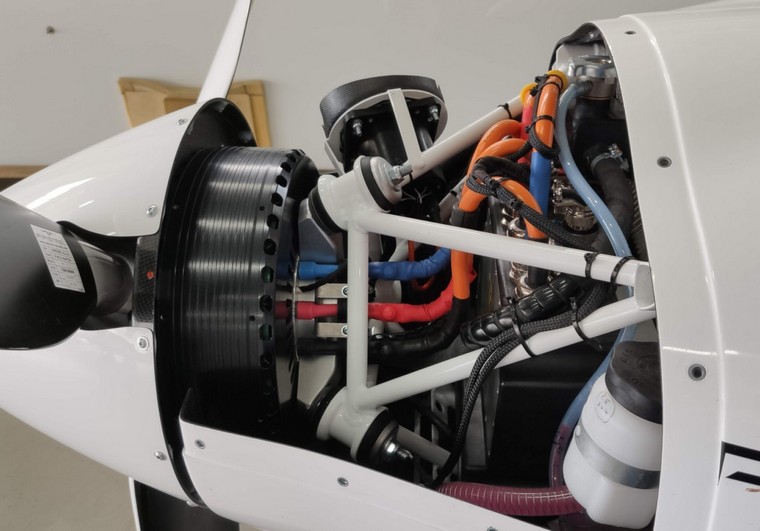 Pipistrel has obtained a type-certification for E-811 as the world's first electric engine certified for use in general aviation. The engine, fully certified by European Union Aviation Safety Agency (EASA), is now also available to other aircraft designers and manufacturers globally. Photo © Pipistrel. The E-811 is extremely flexible: the motor's rotation direction is not factory selected and can be easily adapted to any given application as part of the installation and supports a wide variety of propellers. The propulsion motor is a state-of-the-art axial flux synchronous permanent magnet electric motor. Lighter and more compact, these motors are also more powerful than radial flux motors, making them ideal for their application in aviation. The engine is entirely liquid-cooled through a single cooling circuit with a mixture of 50% water and 50% glycol. The cooling system is part of the installation and can be provided by Pipistrel. Now all the other aircraft OEMs can also enjoy the benefits of a type-certified electric engine or boost the development process of their powered sailplanes, UL, LSA, VLA or Part-23 Level-1 aircraft! Pipistrel's type certification of its electric engine offers an interesting business opportunity. By offering the engine to other OEMs, competitors have the option to reduce their R&D expenses in bringing new aircraft programs to the market. Additionally, this business venture offers Pipistrel with additional revenue streams if sales of their Velis Electro vehicle are lacklustre. This move also makes Pipistrel the first OEM in aerial mobility to offer its engineered components for sale.  EAA SPIRIT OF AVIATION WEEK SCHEDULE HIGHLIGHTS ENTIRE SPECTRUM OF FLIGHT  Highlights from across the world of flight will entertain and educate aviation enthusiasts on July 21-25 as part of the extensive schedule for EAA's Spirit of Aviation Week. That initial schedule was unveiled today as part of the free online experience hosted by the Experimental Aircraft Association. Image © EAA. “The support and participation from across the entire aviation community, including NASA and the U.S. Air Force, has allowed us to create a schedule that truly reaches across the entirety of flying highlights,” said Jack Pelton, EAA CEO and Chairman of the Board. “The content throughout the week is more than something to watch - it is a week where everyone can truly be engaged as an active participant.” Among the features scheduled throughout the week are: • Discussions and content covering homebuilts, vintage aircraft, warbirds, ultralights, chapters, learning to fly, hangar flying, air shows, military aviation, spaceflight, and more • Forums across multiple channels ranging from how-to content and learning to fly to aviation history and technical insights • Multiple live workshops each day on aircraft building and restoration skills • Pilot proficiency content for FAA WINGS credit • Interviews with aviation personalities, plus favourite EAA archive material - some of which has never been seen publicly “While nothing can replace the in-person Oshkosh experience, Spirit of Aviation Week brings multiple channels of highlights throughout each of the five days,” Pelton said. “In that way, it is like being on the AirVenture grounds, where every turn brings a new possibility to discover and engage in everything about aviation. Wherever you are during Spirit of Aviation Week, this experience reminds us that we are indeed #EAATogether.” More activities will be added in the coming days, so check back for additional highlights to come.  EVEKTOR DELIVERS SPORTSTAR RTC AIRCRAFT TO "RIESER FLUGSPORTVEREIN" IN GERMANY 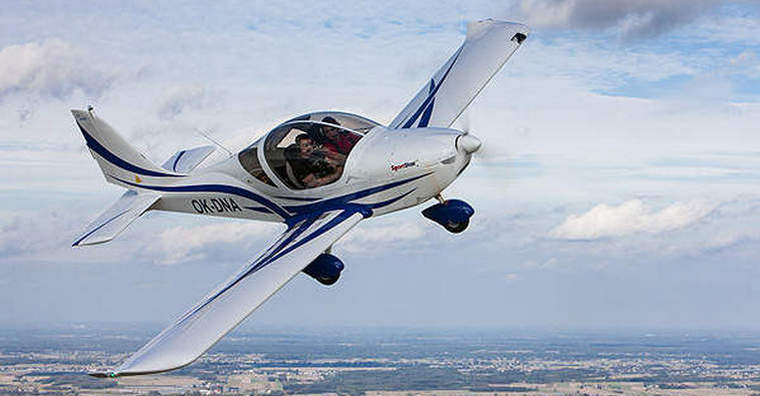 Handover of SportStar RTC, registration mark D-ECAK, was made at the airport in Kamenz on Sunday 28th, June by Flugsportzentrum Bautzen, Evektor authorized sales representative in Germany. SportStar RTC, D-ECAK, is equipped with classic 6-pack analogue instrumentation, Garmin GNC 255A navigation radio, GPS/WAAS transponder Garmin GTX335 and Air Traffic Collision Warning System. The SportStar RTC is EASA certified aircraft for PPL and Night rating training, CPL single engine training and solo time building in flight training organizations and air clubs. For pilot touring of private pilots, the aircraft offers a spacious cabin, best in class useful load and range 1300 km. Evektor is a design, engineering and aircraft manufacturing company from the Czech Republic, with 50 years of aircraft manufacturing experience and sales network support in 40 countries. Evektor produces light sport aircraft and has under development utility a twin engine turboprop EV-55 Outback for the transportation of 9 to 14 passengers. The company produces components for civil and military aircraft industry and has extensive development activities also in automotive and mechanical engineering industries.  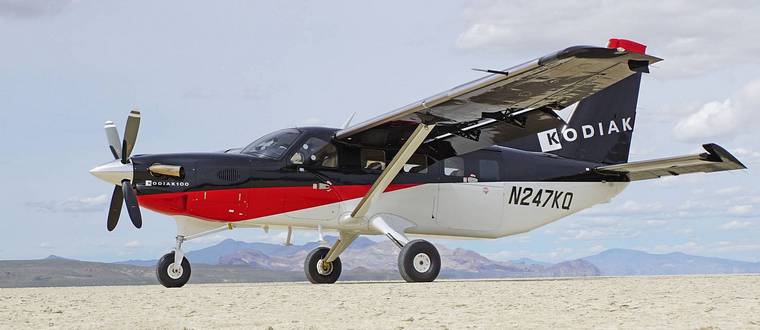 Purchasers of Model Year 2020 versions of the Kodiak 100 aircraft will benefit from free scheduled maintenance during the ?rst two years of ownership with the Kodiak Care Maintenance program announced by Daher. This incentive marks the latest step in Daher's alignment of the support coverage and customer experience for both members of its turboprop-powered general aviation airplane family, the Kodiak and TBM. Image © Daher Aircraft. Additionally, in partnership with the Aircraft Owners and Pilots Association (AOPA), the financing of a Kodiak 100 is available for a limited time at less than $6,000 per month during the ?rst year of ownership. This makes the acquisition of a Model Year 2020 Kodiak 100 for a down payment of only 20 percent and flying for a full year with zero percent interest. New Kodiak 100 owners can benefit as well from the U.S. government's special economic recovery incentives to businesses, in which a taxpayer can receive income tax refunds from as far back as 2015 and 100 percent bonus depreciation with the acquisition of a business aircraft.  STRATOS 716X PERSONAL JET MAKES FIRST FLIGHT  The Stratos 716X single-engine, four-six seat personal jet made its first flight July 2 from the company's factory in Redmond, Oregon. Stratos announced the aircraft in 2018 as a follow-on to the proof-of-concept Model 714. Compared to that aircraft, the 716X has a fuselage that is 31 inches longer and two inches wider. Photo © Stratos. The aircraft is designed to cruise at 400 knots and have a maximum range of 1,500 nm. The 22-minute first flight utilized a full-power take off and climbed to an altitude of 13,500 feet. The carbon-fibre 716X, designed to cruise at 400 knots and with a maximum range of 1,500 nm, is powered by a 3,000 pounds of thrust Pratt & Whitney JT15D-5 turbofan with electronic engine control (EEC) and features Garmin avionic components including dual G3X screens, GTN 750 MFD and integrated Garmin autopilot. It is also equipped with dual standby Mid-Continent attitude indicators, custom switch panels, fully automated pressurization system and air conditioning. “When we introduced the Proof of Concept 714 aircraft three years ago, the marketplace interest was tremendous,” said Stratos CTO Carsten Sundin. “It was clear that the market is looking for the performance and comfort we were offering, but in a true six-place aircraft. We have achieved this with the 716X. With a cabin width of 4.9 feet and height of 4.8 feet, there is plenty of room for passengers to relax on long flights.” Stratos said each seat row features more than 30 inches of legroom. Available seating configurations include a three-place, side-facing divan, all-forward-facing seats and an executive club with forward lavatory area.  LEBANESE AIR FORCE TO SELL FIVE HAWKER HUNTER JETS. 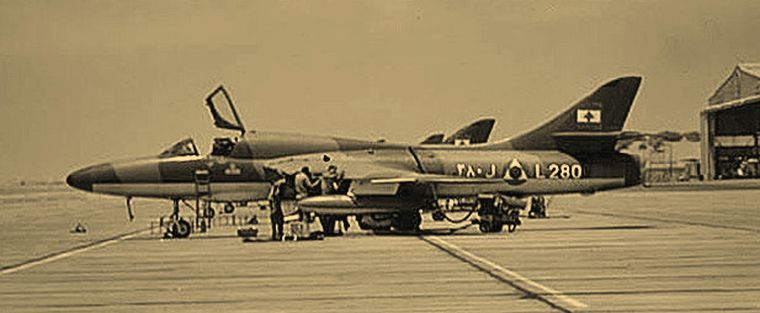 Lebanon has seven aging Hawker Hunters, five of which have been non-operational since 1990, and the other two out of service since 2011. Photo Wikipedia. However, the Lebanese Air Force will keep two Hawker Hunters (one with double seats and the other with a single seat) with some spare parts in hopes they can be fixed up for future air shows. “The scarce economic resources prevent LAF from refurbishing and re-operating the Hawker Hunter fighters. The aircraft are expected to be sold in a public bidding this year.   “This is a tremendous milestone in the history of Gulfstream,” said Mark Burns, president, Gulfstream. “Every Gulfstream model is distinctive and unique in its own way and the G280 is no different. As when it entered the marketplace in 2012, the G280's combination of superior performance, comfort, safety and efficiency puts it atop the midcabin class.” The G280 rolled out in 2009, was certified by the U.S. Federal Aviation Administration in 2012 and entered service that same year. It was certified by the European Union Aviation Safety Agency (EASA) in early 2013. As with all Gulfstream aircraft, the G280 was designed with considerable input from Gulfstream customers who participate in the company's Customer Advisory Board. Based on their feedback, the G280 was designed and built with a new wing, tail, engine and interior. It also features the Gulfstream PlaneView280™ flight deck with Future Air Navigation System 1/A+ capability. Furthermore, it is certified for steep-approach operations and touchdown and rollout using Enhanced Flight Vision System (EFVS). The aircraft is powered by twin Honeywell HTF7250G engines, each providing 7,624 pounds of take-off thrust. The G280, which has achieved 75 city-pair speed records, has a range of 3,600 nautical miles at its long-range cruise speed of Mach 0.80. The comfortable cabin offers multiple floorplan options, seats up to 10 passengers and features Gulfstream-designed cabin management and high-definition entertainment systems, industry-leading cabin sound levels, 19 large oval windows, access to the baggage compartment and several cabin connectivity options, including a high-speed Ka-band satellite system.   Embraer celebrated today the delivery of its 1,600th E-Jet, an E190-E2. Helvetic Airways of Switzerland received the milestone aircraft. Airlines and leasing companies from some 50 countries have added Embraer E-Jets to their fleets since the first-generation jets entered revenue service in 2004. The new, highly fuel-efficient second-generation E-Jets family, the E2s, started flying with airlines in 2018. Photo © Embraer. “It's an honour in my new role as President and CEO of Embraer Commercial Aviation to deliver this landmark aircraft. It's a tremendous milestone in the E-Jets program and in the company's history,” said Arjan Meijer. “Over the years I have been personally very close to Helvetic and their E-Jets fleet planning project. Everyone at Embraer is extremely proud to see such a renowned airline flying our 1,600th production E-Jet.” Helvetic Airways is currently transitioning from a fleet of first-generation E-Jets to E2s. The carrier received its first E190-E2 in October 2019 and has added four more since as part of its fleet renewal program. Helvetic flies the airplanes in a 110-seat single-class configuration on domestic and international routes. The carrier has firm orders for 12 E190-E2s and purchase rights for a further 12 E190-E2s with conversion rights to the E195-E2, bringing the total potential order to 24 E2 aircraft. “We are especially proud to receive an E2 aircraft in these challenging times for our industry,” adds Tobias Pogorevc, CEO of Helvetic Airways. “And it's a genuine privilege to share this special moment with Embraer. We've received very positive feedback on the E190-E2, from our passengers and our crews, since we introduced it into our fleet. We couldn't be happier with the aircraft's performance. The fuel burn is even lower than expected, which makes the airplane even more environmentally friendly. And we're looking forward to resuming operations soon - with our milestone E190-E2 as well.” For nearly two decades, Embraer's innovative E-Jets family has been transforming commercial aviation. It is the industry's most successful line of 70-to-150-seat passenger jets designed specifically for this capacity segment. The program has logged in excess of 1,900 orders to date from more than 100 customers. Some 80 airlines currently fly Embraer E-Jets. The global E-Jet fleet has accumulated more than 30 million flight hours, with an average mission completion rate of 99.9%. The versatile airplanes are flying with low-cost, regional and mainline carriers. The E190-E2 is one of three aircraft in the second-generation E-Jets family. Compared to the first-generation E190, the E190-E2 consumes 17.3% less fuel. This makes it the E2 the most efficient single-aisle aircraft family on the market.  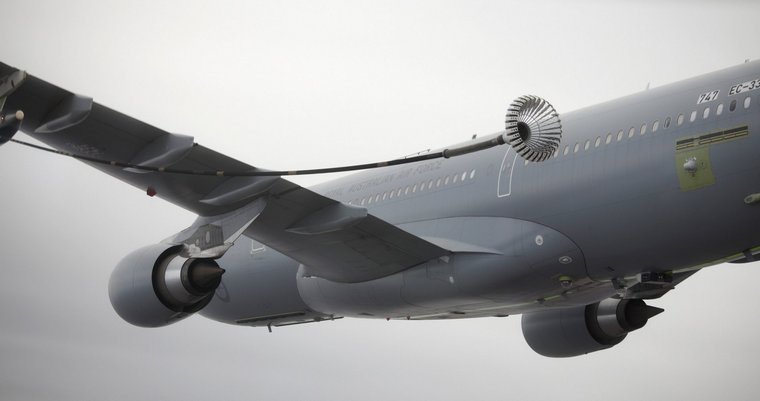 Having earned their reputation as the new-generation aerial tanker of choice for military services worldwide, Airbus' A330 Multi Role Tanker Transports (MRTTs) are now being outfitted for their multi-mission duties in an optimised industrial process - enabling five aircraft to undergo the conversion every year. Photo © Airbus. Having earned its reputation as the new-generation aerial tanker of choice for military services worldwide, Airbus' A330 Multi Role Tanker Transports (MRTTs) are now being outfitted for their multi-mission duties in an optimised industrial process - enabling five aircraft to undergo the conversion every year. During the conversion, Airbus teams install some 16,000 types of new components and approximately 450 new electrical harnesses (for a total cabling length of more than 50 km.), as well as 6,000 brackets and 1,700 connectors. With 42 A330 MRTTs delivered to date, Airbus' has reduced the end-to-end transformation time by one month, introducing increased digitalisation and applying the “takt” principle of lean production methodology - in which the aircraft moves through the conversion with zero hours pending and zero work orders open. A key element of the conversion is installing the A330 MRTT's air-to-air refuelling hardware. All aircraft are equipped with hose and drogue units, and most customers have opted for Airbus' highly capable fly-by-wire Aerial Refuelling Boom System (ARBS) - which provides enhanced controllability during in-flight fuel transfers to receiver airplanes. The A330 MRTT transformation process includes locating the Airbus-developed Air Refuelling Console in the cockpit area behind the pilots. Containing seats for two crew members, this station enables the aerial refuelling to be remotely controlled, aided by an advanced high-resolution observation system with panoramic 3D-vision for operations day and night. On the A330 MRTT's main deck, the aircraft's widebody cross-section can be configured for a variety of roles, from the transportation of troops and personnel with capacities for 268 passengers in a two-class configuration, to aeromedical evacuation - accommodating two intensive care units, 16 stretchers, along with seating for medical staff and passengers. A total of 60 A330 MRTTs have been ordered for operations at the service of 13 nations.  USA  A United Boeing 757-300 on a flight from Chicago O'Hare, to Denver, was climbing out of O'Hare's runway 09R when the crew stopped the climb at 5000 feet reporting a hydraulic problem. While working the checklists the crew requested runway 10L for landing, approach advised they were unavailable and runway 10L was closed. The crew thus accepted runway 10C and advised they would not be able to vacate the runway and needed to be towed off due to lack of nose gear steering, they'd land at a higher than normal speed due to associated minimum flaps. They'd also have no thrust reversers. They landed safely on runway 10C at a higher than normal speed (170 knots over ground) and stopped at the end of the runway. The aircraft was towed to the apron. Photo © Wikimedia. Not the accident aircraft. USA, Idaho: Two sightseeing planes, a Cessna 206 and a de Havilland Beaver collided over Lake Coeur d'Alene in the USA. Both planes crashed and all eight occupants, four in each plane, are presumed to have died in the tragic accident. The planes sank and are under approximately 125 feet of water. USA, New York: A Delta Airlines Airbus A319-100 on a flight from West Palm Beach was on approach to New York's La Guardia Airport descending through about 3000 feet MSL when the aircraft flew through hail. The crew decided to divert to New York's JFK Airport, where the aircraft landed safely on JFK's runway 22R about 10 minutes later. Brazil, Guarulhos Airport: An Azul Linhas Aereas Embraer ERJ-195 on a flight from Belo Horizonte was descending through FL200 towards Congonhas Airport when the crew declared an emergency reporting they had needed to shut an engine down due to a suspected oil leak. The aircraft diverted to Sao Paulo's Guarulhos Airport for a safe landing on runway 09R about 25 minutes later. Emergency services were in their stand by positions but did not need to intervene.   10 July 1935  Bell Aircraft Corporation is founded in Buffalo, New York. Photo © NASA. In 1928 he was hired by Reuben H. Fleet at Consolidated Aircraft, in Buffalo, New York where he was guaranteed an interest in the company. In 1935 Fleet decided to move Consolidated Aircraft to San Diego and Bell stayed behind to establish his own company, the Bell Aircraft Company, on 10 July 1935. Bell's first military contract followed in 1937 with the development of the ill-fated YFM-1 Airacuda, an unconventional bomber-destroyer powered by two Allison-powered pusher propellers. Bell also developed the Reaction Control System for the Mercury Spacecraft, North American X-15 and Bell Rocket Belt. Helicopter development began at Bell Aircraft in 1941 with the Bell Model 30 first flying in 1943. Bell Helicopter became the only part of Bell Aircraft still producing aircraft when Bell was purchased by the Textron Corporation. That part of Textron is now known today as Bell Helicopter. After a series of successful helicopter designs, the UH-1 Iroquois became the most famous helicopter of the War in Vietnam and Bell Helicopter still designs and manufactures helicopters today. Lawrence Bell died in 1956.   |
                           |
 |
 |

Copyright © Pilot's Post PTY Ltd
The information, views and opinions by the authors contributing to Pilot's Post are not necessarily those of the editor or other writers at Pilot's Post.